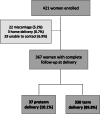Maternal genitourinary infections and poor nutritional status increase risk of preterm birth in Gasabo District, Rwanda: a prospective, longitudinal, cohort study
- PMID: 32493304
- PMCID: PMC7268654
- DOI: 10.1186/s12884-020-03037-0
Maternal genitourinary infections and poor nutritional status increase risk of preterm birth in Gasabo District, Rwanda: a prospective, longitudinal, cohort study
Erratum in
-
Correction: Maternal genitourinary infections and poor nutritional status increase risk of preterm birth in Gasabo District, Rwanda: a prospective, longitudinal, cohort study.BMC Pregnancy Childbirth. 2022 Oct 18;22(1):777. doi: 10.1186/s12884-022-05103-1. BMC Pregnancy Childbirth. 2022. PMID: 36258164 Free PMC article. No abstract available.
Abstract
Background: Preterm birth (PTB) is a leading cause of early childhood mortality and morbidity, including long-term physical and mental impairment. The risk factors for PTB are complex and include maternal nutritional status and infections. This study aimed to identify potentially modifiable risk factors for targeted interventions to reduce the occurrence of PTB in Rwanda.
Methods: We conducted a prospective, longitudinal cohort study of healthy pregnant women aged 18 to 49 years. Women at 9-15 gestational weeks were recruited from 10 health centers in Gasabo District, Kigali Province between September and October 2017. Pregnancy age was estimated using ultrasonography and date of last menstruation. Anthropometric and laboratory measurements were performed using standard procedures for both mothers and newborns. Surveys were administered to assess demographic and health histories. Categorical and continuous variables were depicted as proportions and means, respectively. Variables with p < 0.25 in bivariate analyses were included in multivariable logistic regression models to determine independent predictors of PTB. The results were reported as odds ratios (ORs) and 95% confidence intervals (CI), with statistical significance set at p < 0.05.
Results: Among 367 participants who delivered at a mean of 38.0 ± 2.2 gestational weeks, the overall PTB rate was 10.1%. After adjusting for potential confounders, we identified the following independent risk factors for PTB: anemia (hemoglobin < 11 g/dl) (OR: 4.27; 95%CI: 1.85-9.85), urinary tract infection (UTI) (OR:9.82; 95%CI: 3.88-24.83), chlamydia infection (OR: 2.79; 95%CI: 1.17-6.63), inadequate minimum dietary diversity for women (MDD-W) score (OR:3.94; CI: 1.57-9.91) and low mid-upper arm circumference (MUAC) < 23 cm (OR: 3.12, 95%CI; 1.31-7.43). indicators of nutritional inadequacy (low MDD-W and MUAC) predicted risk for low birth weight (LBW) but only UTI was associated with LBW in contrast with PTB.
Conclusion: Targeted interventions are needed to improve the nutritional status of pregnant women, such as maternal education on dietary diversity and prevention of anemia pre-pregnancy. Additionally, prevention and treatment of maternal infections, especially sexually transmitted infections and UTIs should be reinforced during standard antenatal care screening which currently only includes HIV and syphilis testing.
Keywords: Infection; Nutrition; Risk factors preterm birth.
Conflict of interest statement
The authors declare that they have no competing interests.
Figures
References
-
- March of Dimes, PMNCH, Save the Children W . World Health Organization born too soon. 2012.
-
- Moutquin JM. Classification and heterogeneity of preterm birth. BJOG. 2003;110(SUPPL. 20):30–33. - PubMed
-
- Johanzon M, Ödesjö H, Jacobsson B, Sandberg K, Wennerholm UB. Extreme preterm birth: onset of delivery and its effect on infant survival and morbidity. Obstet Gynecol 2008;111(1):42–50. - PubMed
-
- Menon R. Spontaneous preterm birth, a clinical dilemma: etiologic, pathophysiologic and genetic heterogeneities and racial disparity. Acta Obstet Gynecol Scand. 2008;87(6):590–600. - PubMed


